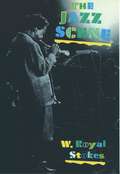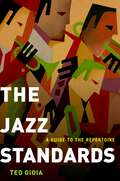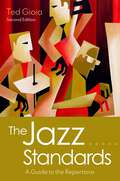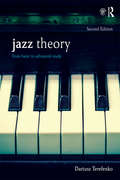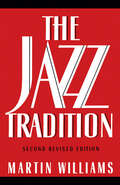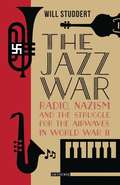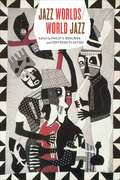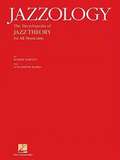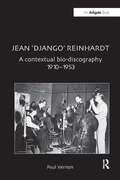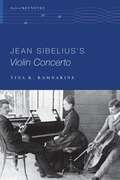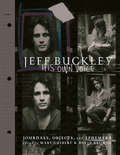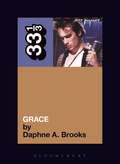- Table View
- List View
The Jazz Scene: An Informal History from New Orleans to 1990
by W. Royal StokesNo one can tell us more about jazz than the musicians themselves. Unfortunately, most oral histories have limited scope--focusing on a particular era or style--and fail to capture the full, rich story of jazz. Now, in this vivid oral history, W. Royal Stokes presents nearly a century of jazz--its people, places, periods, and styles--as it was seen by the artists who created America's most distinctive music. Here, along with the author's enlightening commentary, are the words of musicians famous and little-known, veterans of the early years and pathbreakers of the present, telling us about their origins and adventures, about the places and performers they have known. We read of young artists learning their skills surrounded by poverty, going on to win fame around the world. We feel the excitement of jazz before the war ("The music was all over the place," recalled Wild Bill Davison. "It's just unbelievable how many bands there were in Chicago. You could go anywhere and there'd be a band."). And we glimpse the gritty, hard life hidden beneath the beauty of the notes they played: "I remember not eating practically a month several times," said Mary Lou Williams. "During the depression we played engagements and we knew we weren't going to get any money because Andy would scatch his face when he was walking toward the band and the trumpet player would pull out his horn and play the 'Weary Blues.' And we'd laugh about it. We hadn't eaten in a couple of days and nothing was said, because the music was our survival." Stokes not only uncovers the history of jazz in the major cities and regions--New Orleans, for instance, Chicago in the '20s and '30s, Kansas City, and California from the '50s to the present--but he goes on to bring us the story of the big bands, post-bebop developments, vocalists, jazz around the globe, and the contemporary scene ("I was about eleven and my brother Mike started to bring home a lot of Miles Davis records from school and that did it for me," remembers Pat Metheny. "First time I heard Miles playing 'My Funny Valentine,' that whole record just destroyed me."). And he takes a close look at the rising place of women as instrumentalists in the last decade. Jazz is America's most original contribution to music, and--as the late Dexter Gordon lamented--America is the one country where it is little known. But W. Royal Stokes uncovers a scene that is as alive as ever, with this fascinating look at how it has been made and remade from the first decades of the century to today.
Jazz Sells: Music, Marketing, and Meaning
by Mark LaverJazz Sells: Music, Marketing, and Meaning examines the issues of jazz, consumption, and capitalism through advertising. On television, on the Internet, in radio, and in print, advertising is a critically important medium for the mass dissemination of music and musical meaning. This book is a study of the use of the jazz genre as a musical signifier in promotional efforts, exploring how the relationship between brand, jazz music, and jazz discourses come together to create meaning for the product and the consumer. At the same time, it examines how jazz offers an invaluable lens through which to examine the complex and often contradictory culture of consumption upon which capitalism is predicated.
Jazz Sells: Music, Marketing, and Meaning
by Mark LaverJazz Sells: Music, Marketing, and Meaning examines the issues of jazz, consumption, and capitalism through advertising. On television, on the Internet, in radio, and in print, advertising is a critically important medium for the mass dissemination of music and musical meaning. This book is a study of the use of the jazz genre as a musical signifier in promotional efforts, exploring how the relationship between brand, jazz music, and jazz discourses come together to create meaning for the product and the consumer. At the same time, it examines how jazz offers an invaluable lens through which to examine the complex and often contradictory culture of consumption upon which capitalism is predicated.
The Jazz Standards: A Guide to the Repertoire
by Ted GioiaThe Jazz Standards, a comprehensive guide to the most important jazz compositions, is a unique resource, a browser's companion, and an invaluable introduction to the art form. This essential book for music lovers tells the story of more than 250 key jazz songs, and includes a listening guide to more than 2,000 recordings. Many books recommend jazz CDs or discuss musicians and styles, but this is the first to tell the story of the songs themselves. The fan who wants to know more about a jazz song heard at the club or on the radio will find this book indispensable. Musicians who play these songs night after night now have a handy guide, outlining their history and significance and telling how they have been performed by different generations of jazz artists. Students learning about jazz standards now have a complete reference work for all of these cornerstones of the repertoire. Author Ted Gioia, whose body of work includes the award-winning The History of Jazz and Delta Blues, is the perfect guide to lead readers through the classics of the genre. As a jazz pianist and recording artist, he has performed these songs for decades. As a music historian and critic, he has gained a reputation as a leading expert on jazz. Here he draws on his deep experience with this music in creating the ultimate work on the subject. An introduction for new fans, a useful handbook for jazz enthusiasts and performers, and an important reference for students and educators, The Jazz Standards belongs on the shelf of every serious jazz lover or musician.
The Jazz Standards: A Guide to the Repertoire
by Ted GioiaAn updated new edition of Ted Gioia's acclaimed compendium of jazz standards, featuring 15 additional selections, hundreds of additional recommended tracks, and enhancements and additions on almost every page. Since the first edition of The Jazz Standards was published in 2012, author Ted Gioia has received almost non-stop feedback and suggestions from the passionate global community of jazz enthusiasts and performers requesting crucial additions and corrections to the book. In this second edition, Gioia expands the scope of the book to include more songs, and features new recordings by rising contemporary artists. The Jazz Standards is an essential comprehensive guide to some of the most important jazz compositions, telling the story of more than 250 key jazz songs and providing a listening guide to more than 2,000 recordings. The fan who wants to know more about a tune heard at the club or on the radio will find this book indispensable. Musicians who play these songs night after night will find it to be a handy guide, as it outlines the standards' history and significance and tells how they have been performed by different generations of jazz artists. Students learning about jazz standards will find it to be a go-to reference work for these cornerstones of the repertoire. This book is a unique resource, a browser's companion, and an invaluable introduction to the art form.
The Jazz Standards: A Guide to the Repertoire
by Ted GioiaAn updated new edition of Ted Gioia's acclaimed compendium of jazz standards, featuring 15 additional selections, hundreds of additional recommended tracks, and enhancements and additions on almost every page. Since the first edition of The Jazz Standards was published in 2012, author Ted Gioia has received almost non-stop feedback and suggestions from the passionate global community of jazz enthusiasts and performers requesting crucial additions and corrections to the book. In this second edition, Gioia expands the scope of the book to include more songs, and features new recordings by rising contemporary artists. The Jazz Standards is an essential comprehensive guide to some of the most important jazz compositions, telling the story of more than 250 key jazz songs and providing a listening guide to more than 2,000 recordings. The fan who wants to know more about a tune heard at the club or on the radio will find this book indispensable. Musicians who play these songs night after night will find it to be a handy guide, as it outlines the standards' history and significance and tells how they have been performed by different generations of jazz artists. Students learning about jazz standards will find it to be a go-to reference work for these cornerstones of the repertoire. This book is a unique resource, a browser's companion, and an invaluable introduction to the art form.
Jazz Theory: From Basic to Advanced Study
by Dariusz TerefenkoJazz Theory: From Basic to Advanced Study, Second Edition, is a comprehensive textbook for those with no previous study in jazz, as well as those in advanced theory courses. Written with the goal to bridge theory and practice, it provides a strong theoretical foundation from music fundamentals to post-tonal theory, while integrating ear training, keyboard skills, and improvisation. It hosts "play-along" audio tracks on a Companion Website, including a workbook, ear-training exercises, and an audio compilation of the musical examples featured in the book. Jazz Theory is organized into three parts: Basics, Intermediate, and Advanced. This approach allows for success in a one-semester curriculum or with subsequent terms. If students sense that theory can facilitate their improvisational skills or can help them develop their ears, they become more engaged in the learning process. The overall pedagogical structure accomplishes precisely that in an original, creative—and above all, musical—manner. KEY FEATURES include 390 musical examples, ranging from original lead sheets of standard tunes, jazz instrumentals, transcriptions, and original compositions, to fully realized harmonic progressions, sample solos, and re-harmonized tunes. The completely revamped Companion Website hosts: 46 "Play Along Sessions" audio tracks, offering experiences close to real-time performance scenarios. Over 1,000 (audio and written) exercises covering ear training, rhythm, notation, analysis, improvisation, composition, functional keyboard, and others. Recordings of all 390 musical examples from the textbook. Links: Guide to Making Transcriptions, List of Solos to Transcribe, Selected Discography, Classification of Standard Tunes, and more. Lists of well-known standard tunes, including a comprehensive list of 999 Standard Tunes – Composers and Lyricists. NEW TO THE SECOND EDITION are instructors’ tools with answer keys to written and ear-training exercises, 380 rhythmic calisthenics featuring exercises from the swing, bebop, and Latin rhythmic traditions, a new improvisation section, a set of 140 Comprehensive Keyboard exercises, plus an expanded ear-training section with 125 melodic, 50 rhythmic dictations, and 170 harmonic dictations, plus 240 written exercises, 25 composition assignments, and 110 singing exercises.
Jazz Theory: From Basic to Advanced Study
by Dariusz TerefenkoJazz Theory: From Basic to Advanced Study, Second Edition, is a comprehensive textbook for those with no previous study in jazz, as well as those in advanced theory courses. Written with the goal to bridge theory and practice, it provides a strong theoretical foundation from music fundamentals to post-tonal theory, while integrating ear training, keyboard skills, and improvisation. It hosts "play-along" audio tracks on a Companion Website, including a workbook, ear-training exercises, and an audio compilation of the musical examples featured in the book. Jazz Theory is organized into three parts: Basics, Intermediate, and Advanced. This approach allows for success in a one-semester curriculum or with subsequent terms. If students sense that theory can facilitate their improvisational skills or can help them develop their ears, they become more engaged in the learning process. The overall pedagogical structure accomplishes precisely that in an original, creative—and above all, musical—manner. KEY FEATURES include 390 musical examples, ranging from original lead sheets of standard tunes, jazz instrumentals, transcriptions, and original compositions, to fully realized harmonic progressions, sample solos, and re-harmonized tunes. The completely revamped Companion Website hosts: 46 "Play Along Sessions" audio tracks, offering experiences close to real-time performance scenarios. Over 1,000 (audio and written) exercises covering ear training, rhythm, notation, analysis, improvisation, composition, functional keyboard, and others. Recordings of all 390 musical examples from the textbook. Links: Guide to Making Transcriptions, List of Solos to Transcribe, Selected Discography, Classification of Standard Tunes, and more. Lists of well-known standard tunes, including a comprehensive list of 999 Standard Tunes – Composers and Lyricists. NEW TO THE SECOND EDITION are instructors’ tools with answer keys to written and ear-training exercises, 380 rhythmic calisthenics featuring exercises from the swing, bebop, and Latin rhythmic traditions, a new improvisation section, a set of 140 Comprehensive Keyboard exercises, plus an expanded ear-training section with 125 melodic, 50 rhythmic dictations, and 170 harmonic dictations, plus 240 written exercises, 25 composition assignments, and 110 singing exercises. The paperback TEXTBOOK is also paired with the corresponding paperback WORKBOOK in a discounted PACKAGE (9780367321963).
Jazz Theory Workbook: From Basic to Advanced Study
by Dariusz TerefenkoJazz Theory Workbook accompanies the second edition of the successful Jazz Theory—From Basic to Advanced Study textbook designed for undergraduate and graduate students studying jazz. The overall pedagogy bridges theory and practice, combining theory, aural skills, keyboard skills, and improvisation into a comprehensive whole. While the Companion Website for the textbook features aural and play-along exercises, along with some written exercises and the answer key, this workbook contains brand-new written exercises, as well as as well as four appendices: (1) Rhythmic Exercises, (2) Common-Practice Harmony at the Keyboard, (3) Jazz Harmony at the Keyboard, and (4) Patterns for Jazz Improvisaton. Jazz Theory Workbook works in tandem with its associated textbook in the same format as the 27-chapter book, yet is also designed to be used on its own, providing students and readers with quick access to all relevant exercises without the need to download or print pages that inevitably must be written out. The workbook is sold both on its own as well as discounted in a package with the textbook. Jazz Theory Workbook particularly serves the ever-increasing population of classical students interested in jazz theory or improvisation. This WORKBOOK is available for individual sale in various formats: Print Paperback: 9781138334250 Print Hardback: 9781138334243 eBook: 9780429445477 The paperback WORKBOOK is also paired with the corresponding paperback TEXTBOOK in a discounted PACKAGE (9780367321963).
Jazz Theory Workbook: From Basic to Advanced Study
by Dariusz TerefenkoJazz Theory Workbook accompanies the second edition of the successful Jazz Theory—From Basic to Advanced Study textbook designed for undergraduate and graduate students studying jazz. The overall pedagogy bridges theory and practice, combining theory, aural skills, keyboard skills, and improvisation into a comprehensive whole. While the Companion Website for the textbook features aural and play-along exercises, along with some written exercises and the answer key, this workbook contains brand-new written exercises, as well as as well as four appendices: (1) Rhythmic Exercises, (2) Common-Practice Harmony at the Keyboard, (3) Jazz Harmony at the Keyboard, and (4) Patterns for Jazz Improvisaton. Jazz Theory Workbook works in tandem with its associated textbook in the same format as the 27-chapter book, yet is also designed to be used on its own, providing students and readers with quick access to all relevant exercises without the need to download or print pages that inevitably must be written out. The workbook is sold both on its own as well as discounted in a package with the textbook. Jazz Theory Workbook particularly serves the ever-increasing population of classical students interested in jazz theory or improvisation. This WORKBOOK is available for individual sale in various formats: Print Paperback: 9781138334250 Print Hardback: 9781138334243 eBook: 9780429445477 The paperback WORKBOOK is also paired with the corresponding paperback TEXTBOOK in a discounted PACKAGE (9780367321963).
The Jazz Tradition
by Martin WilliamsWhen it was first published in 1970, this lively and fascinating book was greeted with almost universal acclaim. The American Record Guide called it "the best one-volume of jazz we have," and the Jazz Journal praised it as "a brilliant study of the whole of jazz." Perhaps the greatest tribute was paid by Louis Armstrong himself who raved: "it held Ol' Satch spellbound." Now thoroughly revised and expanded, the new edition of The Jazz Tradition offers readers a unique history of jazz, as seen through its greatest practitioners. An original blend of history and criticism, this book explores the work of nearly two dozen leading musicians and ensembles that have shaped the course of jazz, from King Oliver's Creole Jazz band to the present day. Couched in the same readable, non-technical language that made earlier editions so popular, The Jazz Tradition adds new chapters on some of the more recent giants of jazz, performers like pianist Bill Evans, versatile horn player and saxophonist Eric Dolphy, and the World Saxophone Quartet, and considerably expands the chapter devoted to Count Basie. In addition, a foreword by Richard Crawford introduces the new edition, and the discographies on each performer have been fully brought up to date. Written by an author The Washington Post lauded as "the most knowledgeable, open-minded, and perceptive American jazz critic today," The Jazz Tradition belongs in the library of all lovers of this distinctly American sound.
The Jazz War: Radio, Nazism and the Struggle for the Airwaves in World War II
by Will StuddertDuring World War II, jazz embodied everything that was appealing about a democratic society as envisioned by the Western Allied powers. Labelled `degenerate' by Hitler's cultural apparatus, jazz was adopted by the Allies to win the hearts and minds of the German public. It was also used by the Nazi Minister for Propaganda, Joseph Goebbels, to deliver a message of Nazi cultural and military superiority. When Goebbels co-opted young German and foreign musicians into `Charlie and his Orchestra' and broadcast their anti-Allied lyrics across the English Channel, jazz took centre stage in the propaganda war that accompanied World War II on the ground. The Jazz War is based on the largely unheard oral testimony of the personalities behind the German and British wartime radio broadcasts, and chronicles the evolving relationship between jazz music and the Axis and Allied war e orts. Studdert shows how jazz both helped and hindered the Allied cause as Nazi soldiers secretly tuned in to British radio shows while London party-goers danced the night away in demimonde `bottle parties', leading them to be branded a `menace' in Parliament. This book will appeal to students of the history of jazz, broadcasting, cultural studies, and the history of World War II.
Jazz Worlds/World Jazz (Chicago Studies in Ethnomusicology)
by Philip Bohlman Goffredo Plastino Philip V. BohlmanMany regard jazz as the soundtrack of America, born and raised in its cities and echoing throughout its tumultuous century of progress. So when Ernest Hemingway wrote about seeing jazz in 1920s Paris, and when British colonial officials danced to jazz in the clubs of Calcutta in the waning years of the Raj, how, exactly, had it gotten there? Jazz Worlds/World Jazz aims to answer these questions and more, bringing together voices from countries as far flung as Azerbaijan, Armenia, and India to show that the story of jazz is not trapped in American history books but alive in global modernity. Monumental in scope, this book explores the relationship between jazz and culture and how they influence each other across a range of themes and settings. Contributors offer an analysis of the social meaning of jazz in Iran, a look at the genesis of Ethiopian jazz and at Indian fusion, and chapters on jazz diplomacy, Balkan swing, and that French export par excellence: Django Reinhardt. Altogether the contributors approach jazz—in these global iterations—through the themes that have always characterized it at home: place, history, mobility, media, and race. The result is a first-of-its-kind map of jazz around the globe that pays tribute to the players who have given the form its seemingly infinite possibilities.
Jazzology: The Encyclopedia of Jazz Theory for all Musicians (PDF) (Jazz Instruction Ser.)
by Robert Rawlins Nor Eddine BahhaA one-of-a-kind book encompassing a wide scope of jazz topics, for beginners and pros of any instrument. A three-pronged approach was envisioned with the creation of this comprehensive resource: as an encyclopedia for ready reference, as a thorough methodology for the student, and as a workbook for the classroom, complete with ample exercises and conceptual discussion. Includes the basics of intervals, jazz harmony, scales and modes, ii-V-I cadences. For harmony, it covers: harmonic analysis, piano voicings and voice leading; modulations and modal interchange, and reharmonization. For performance, it takes players through: jazz piano comping, jazz tune forms, arranging techniques, improvisation, traditional jazz fundamentals, practice techniques, and much more!
Je t’aime: The legendary love story of Jane Birkin and Serge Gainsbourg
by Véronique MortaigneBBC RADIO 4 BOOK OF THE WEEK 18-22nd FEBRUARY 2019 Marking the 50-year anniversary of the legendary banned song Je t’aime… moi non plus, Véronique Mortaigne’s brilliantly-written book skilfully identifies the pairing of Gainsbourg and Birkin as an expression of the spirit of the age. Synonymous with love, eroticism, glamour, music, provocation, their affair would set France aflame as the sixties ebbed, and set in motion many of the ideas we have by now come to think of as specifically ‘French’. Skipping back and forth in time, Je t'aime takes the reader from the foggy Normandy landscapes where Serge and Jane retreated, to their carefree summers on the coast. En route to their superstardom in films and music, we experience their intrigues, triangular relationships, and jealous rages, the genius and the self-torture. Tenderly told, via new interviews with key players in their story, Je t'aime details the coming together of two massive personalities, who together created a model of the rebel couple for the ages.
Jean 'Django' Reinhardt: A Contextual Bio-Discography 1910-1953
by Paul VernonThis volume gathers together and organizes in an easily accessible format all known information relevant to the life and work of the French jazz musician Django Reinhardt. Together with fellow musician, St ane Grappelli, Reinhardt became one of the twentieth century's most celebrated jazz artists with performances he gave as part of the Quintet of the Hot Club of France. Essentially discographical in format, this book updates the original work compiled by Charles Delauney in 1960, and draws on later work by Gould, Nevers, Royal and Rust, to detail all known recordings by Reinhardt, together with known film, radio and television appearances. For each entry Paul Vernon provides, where known, the location of the recording, the date, the artist credit as it appears on the label of the original issue, the performers and the instruments played by them, the matrix number, the exact timing of the recording and details of 78, LP, EP and CD issues. Interspersed at the appropriate chronological points are biographical details about Reinhardt and the political, social and cultural climate of his time. This is augmented with excerpts from reviews, letters and other documents to provide a vivid context for his recording work.
Jean 'Django' Reinhardt: A Contextual Bio-Discography 1910-1953
by Paul VernonThis volume gathers together and organizes in an easily accessible format all known information relevant to the life and work of the French jazz musician Django Reinhardt. Together with fellow musician, St ane Grappelli, Reinhardt became one of the twentieth century's most celebrated jazz artists with performances he gave as part of the Quintet of the Hot Club of France. Essentially discographical in format, this book updates the original work compiled by Charles Delauney in 1960, and draws on later work by Gould, Nevers, Royal and Rust, to detail all known recordings by Reinhardt, together with known film, radio and television appearances. For each entry Paul Vernon provides, where known, the location of the recording, the date, the artist credit as it appears on the label of the original issue, the performers and the instruments played by them, the matrix number, the exact timing of the recording and details of 78, LP, EP and CD issues. Interspersed at the appropriate chronological points are biographical details about Reinhardt and the political, social and cultural climate of his time. This is augmented with excerpts from reviews, letters and other documents to provide a vivid context for his recording work.
Jean Langlais: A Bio-Bibliography (Bio-Bibliographies in Music)
by Kathleen ThomersonThis is the first book on the French composer Jean Langlais to be published in English and also the first to provide complete information on all of his published works plus 86 unplubished compositions, and eleven orchestral works. This book traces Langlais' development from his early years of study at the National Institute for the Young Blind, through his long and active career as composer, church musician, and concert organist, and explores the impact that Langlais' hard work, determination, and talent have had on the musical world. It is divided into five major sections, including a biography, interviews, works and performances, a discography, and a bibliography. Listing 240 compositions written between 1927 and 1987, and containing a complete discography of both commercially produced and privately released recordings, the major portion of this volume is an annotated bibliography of writings by and about Langlais, with 536 entries, covering the years from 1926 to 1987, when he celebrated his eightieth birthday. Categories include general references, individual compositions, improvisations, reviews of recordings, nonprint sources, and archive information. There is valuable information on premieres, reactions to Langlais' works and performances, recital programs, and correspondence. The opus numbers, recently completed by Marie-Louise Jaquet-Langlais, the composer's wife, are published here for the first time in a chronological list of compositions, and the index section covers works, authors and translators, and general information.
Jean Sibelius and His World
by Daniel M. GrimleyPerhaps no twentieth-century composer has provoked a more varied reaction among the music-loving public than Jean Sibelius (1865-1957). Originally hailed as a new Beethoven by much of the Anglo-Saxon world, he was also widely disparaged by critics more receptive to newer trends in music. At the height of his popular appeal, he was revered as the embodiment of Finnish nationalism and the apostle of a new musical naturalism. Yet he seemingly chose that moment to stop composing altogether, despite living for three more decades. Providing wide cultural contexts, contesting received ideas about modernism, and interrogating notions of landscape and nature, Jean Sibelius and His World sheds new light on the critical position occupied by Sibelius in the Western musical tradition. The essays in the book explore such varied themes as the impact of Russian musical traditions on Sibelius, his compositional process, Sibelius and the theater, his understanding of music as a fluid and improvised creation, his critical reception in Great Britain and America, his "late style" in the incidental music for The Tempest, and the parallel contemporary careers of Sibelius and Richard Strauss. Documents include the draft of Sibelius's 1896 lecture on folk music, selections from a roman à clef about his student circle in Berlin at the turn of the century, Theodor Adorno's brief but controversial tirade against the composer, and the newspaper debates about the Sibelius monument unveiled in Helsinki a decade after the composer's death. The contributors are Byron Adams, Leon Botstein, Philip Ross Bullock, Glenda Dawn Goss, Daniel Grimley, Jeffrey Kallberg, Tomi Mäkelä, Sarah Menin, Max Paddison, and Timo Virtanen.
Jean Sibelius and His World
by Daniel M. GrimleyPerhaps no twentieth-century composer has provoked a more varied reaction among the music-loving public than Jean Sibelius (1865-1957). Originally hailed as a new Beethoven by much of the Anglo-Saxon world, he was also widely disparaged by critics more receptive to newer trends in music. At the height of his popular appeal, he was revered as the embodiment of Finnish nationalism and the apostle of a new musical naturalism. Yet he seemingly chose that moment to stop composing altogether, despite living for three more decades. Providing wide cultural contexts, contesting received ideas about modernism, and interrogating notions of landscape and nature, Jean Sibelius and His World sheds new light on the critical position occupied by Sibelius in the Western musical tradition. The essays in the book explore such varied themes as the impact of Russian musical traditions on Sibelius, his compositional process, Sibelius and the theater, his understanding of music as a fluid and improvised creation, his critical reception in Great Britain and America, his "late style" in the incidental music for The Tempest, and the parallel contemporary careers of Sibelius and Richard Strauss. Documents include the draft of Sibelius's 1896 lecture on folk music, selections from a roman à clef about his student circle in Berlin at the turn of the century, Theodor Adorno's brief but controversial tirade against the composer, and the newspaper debates about the Sibelius monument unveiled in Helsinki a decade after the composer's death. The contributors are Byron Adams, Leon Botstein, Philip Ross Bullock, Glenda Dawn Goss, Daniel Grimley, Jeffrey Kallberg, Tomi Mäkelä, Sarah Menin, Max Paddison, and Timo Virtanen.
Jean Sibelius's Violin Concerto (The Oxford Keynotes Series)
by Tina K. RamnarineJean Sibelius's Violin Concerto is the story of Sibelius as performer and composer, of violin performing traditions, of histories of musical transmission, and of virtuosity itself. It investigates the history and legacy of one of the most recorded concertos in the violin repertoire. Sibelius, a celebrated and influential composer of the late 19th and 20th centuries, was an accomplished violinist, whose enduring interest in the instrument has been paralleled by the broad success of the only concerto in his oeuvre: his violin concerto (premiered in 1904 and revised in 1905). Considering how violinists engage with the work, author Tina K. Ramnarine discusses technology's central role in the concerto's transmission from Jascha Heifetz's seminal 1935 recording to contemporary online performances, gender issues in violin solo careers, and nature-based musical aesthetics that lead to thinking about the ecology of virtuosity in an era of environmental crisis. Beginning with Sibelius's early training as a violinist and his aspirations as a performer, Ramnarine traces the dramatic historical context of the violin concerto. It was composed as Finland underwent a period of heightened self-determination, nationalism, and protest against Russian imperial policies, and it heralded intense political dynamics relating to Europe's East-West border that have extended to the present. This story of the violin concerto points to the notion of Sibelius - and the virtuoso more generally - as a political figure.
JEAN SIBELIUSS VIOLIN CONCERTO C (The Oxford Keynotes Series)
by Tina K. RamnarineJean Sibelius's Violin Concerto is the story of Sibelius as performer and composer, of violin performing traditions, of histories of musical transmission, and of virtuosity itself. It investigates the history and legacy of one of the most recorded concertos in the violin repertoire. Sibelius, a celebrated and influential composer of the late 19th and 20th centuries, was an accomplished violinist, whose enduring interest in the instrument has been paralleled by the broad success of the only concerto in his oeuvre: his violin concerto (premiered in 1904 and revised in 1905). Considering how violinists engage with the work, author Tina K. Ramnarine discusses technology's central role in the concerto's transmission from Jascha Heifetz's seminal 1935 recording to contemporary online performances, gender issues in violin solo careers, and nature-based musical aesthetics that lead to thinking about the ecology of virtuosity in an era of environmental crisis. Beginning with Sibelius's early training as a violinist and his aspirations as a performer, Ramnarine traces the dramatic historical context of the violin concerto. It was composed as Finland underwent a period of heightened self-determination, nationalism, and protest against Russian imperial policies, and it heralded intense political dynamics relating to Europe's East-West border that have extended to the present. This story of the violin concerto points to the notion of Sibelius - and the virtuoso more generally - as a political figure.
Jeff Buckley: The Official Journals, Objects, and Ephemera
by David Browne Mary GuibertPRE ORDER NOW AND BECOME ONE OF THE FIRST TO READ THE OFFICIAL BIOGRAPHY OF THE LATE SINGER JEFF BUCKLEY. INCLUDES NEVER SEEN BEFORE HANDWRITTEN LYRICS, JOURNALS AND DIARIES.In 1994, an artist named Jeff Buckley released 'Grace', his debut album. Hailed immediately by the likes of Bono, Jimmy Page, and Robert Plant, as a singer, guitarist, and writer of a generation.Throughout his life, Buckley obsessively kept journals chronicling his goals, inspirations, aspirations, and creative struggles. His diaries amount to one of the most insightful life chronicles any musical artist has ever left behind. Jeff Buckley: His Own Voice will mark the first-ever publication of Buckley's account of his journey through his handwritten diaries and lyrics. Combined with reproductions of other memorabilia, including letters, notes, and unpublished lyrics - the book will take readers deep inside Buckley's creative mind and personal life. For those who grew up listening to Jeff's music and for those who are just discovering it, Jeff Buckley: His Own Voice will be an intimate portrait of one of the most influential musicians of the 20th century in his own extremely vibrant words and never seen before lyrics.
Jeff Buckley's Grace (33 1/3)
by Daphne A. BrooksThe power and influence of Grace increases with each passing year. Here, Daphne Brooks traces Jeff Buckley's fascinating musical development through the earliest stages of his career, up to the release of the album. With access to rare archival material, Brooks illustrates Buckley's passion for life and hunger for musical knowledge, and shows just why he was such a crucial figure in the American music scene of the 1990s.EXCERPT:Jeff Buckley was piecing together a contemporary popular music history for himself that was steeped in the magic of singing. He was busy hearing how Dylan channeled Billie Holiday in Blonde On Blonde and how Robert Plant was doing his best to sound like Janis Joplin on early Led Zeppelin recordings. He was thinking about doo-wop and opera and Elton John and working at developing a way to harness the power of the voice...In the process, he was re-defining punk and grunge "attitude" itself by rejecting the ambivalent sexual undercurrents of those movements, as well as Led Zeppelin's canonical "cock rock" kingdom that he'd grown up adoring. He was forging a one-man revolution set to the rhythms of New York City and beyond. And he was on the brink of recording his elegant battle in song for the world to hear.
